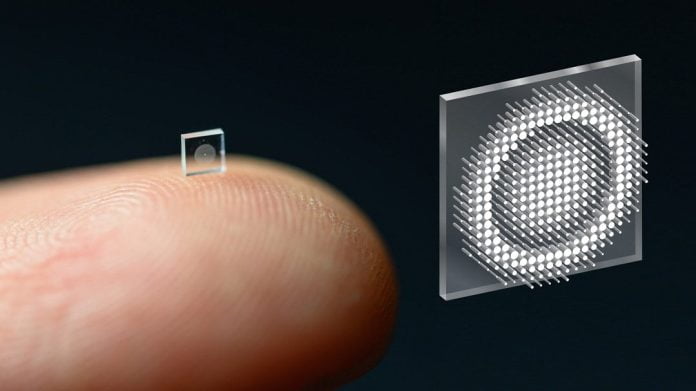Researchers at Princeton University and the University of Washington have developed an ultracompact camera the size of a grain of salt thanks to a new lens technology called metasurface.
Metasurface is half a millimetre wide, comprised of 1.6 million cylindrical posts, can be produced like a computer chip and used in a range of applications, from medical imaging to video surveillance.
According to researchers, the camera system can produce sharp, colour images that match the performance of a conventional compound camera lens 500,000 times larger in volume and be positioned on any surface a camera is required.
Each metasurface lens post has a unique geometry, and functions like an optical antenna. Varying the design of each post is necessary to correctly shape the entire optical wavefront. With the help of machine learning-based algorithms, the posts’ interactions with light combine to produce the highest-quality images and widest field of view for a full-colour metasurface camera developed to date.
A key innovation in the camera’s creation was the integrated design of the optical surface and the signal processing algorithms that produce the image. This boosted the camera’s performance in natural light conditions, in contrast to previous metasurface cameras that required the pure laser light of a laboratory or other ideal conditions to produce high-quality images, according to Felix Heide, the study’s senior author and an assistant professor of computer science at Princeton.
Other ultracompact metasurface lenses have suffered from major image distortions, small fields of view, and limited ability to capture the full spectrum of visible light—referred to as RGB imaging because it combines red, green and blue to produce different hues.
“It’s been a challenge to design and configure these little microstructures to do what you want,” said Ethan Tseng, a computer science Ph.D. student at Princeton who co-led the study. “For this specific task of capturing large field of view RGB images, it’s challenging because there are millions of these little microstructures, and it’s not clear how to design them in an optimal way.”
Co-lead author Shane Colburn tackled this challenge by creating a computational simulator to automate testing of different nano-antenna configurations. Because of the number of antennas and the complexity of their interactions with light, this type of simulation can use “massive amounts of memory and time,” said Colburn. He developed a model to efficiently approximate the metasurfaces’ image production capabilities with sufficient accuracy.
Coauthor James Whitehead, a Ph.D. student at UW ECE, fabricated the metasurfaces, which are based on silicon nitride, a glass-like material that is compatible with standard semiconductor manufacturing methods used for computer chips. This fabrication suggests metasurface designs could be easily mass-produced at lower cost than the lenses in conventional cameras.
#sen.news #SEN #SENnews #security #electronics











